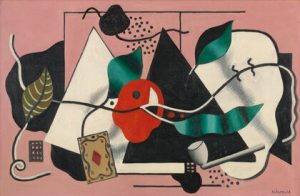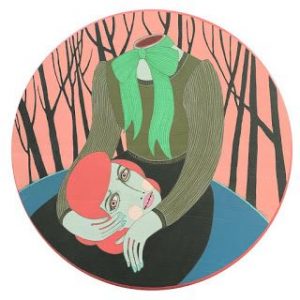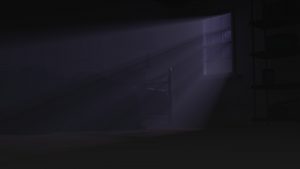The Room in the Attic
The short story “The Room in the Attic” is about a teenage boy who becomes infatuated with the sister of his friend, who he only ever interacts with in her darkened bedroom in the attic. At first he is understandably curious about what she looks like and plans to reveal her with a flashlight, but decides against that as it would have been an invasion of her boundaries. As time goes on, however, he comes to conflate her with the darkness. He talks about two worlds: the world of the light and the world of the dark. Isabel is a creature of the latter, and as he becomes infatuated with her he seems to become engulfed in the dark as well. The world of the dark is mysterious, unburdened by appearances, it is in a way richer. In the dark, he can imagine Isabel to be anything or anyone, while in the light his image of her fades and becomes unclear. He comes to much prefer the dark.
Before meeting Isabel, David says: “In a murky sense I felt that my secret reading was a way of burrowing down to that underplace, where a truer or better version of myself lay waiting for me.” It seems to me that the world David imagines to exist in the dark of Isabel’s room is another manifestation of this mindset. She and the dark she inhabits are vessels that he uses to carry him to a “truer or better version of [himself].” The dark is a place for him to explore himself, a world of his own mind.
Wolf, on the other hand, sees a book as a “dream-machine” whose purpose is escapism. I think that this view can also apply to David’s perception of Isabel and the world of the dark. After all, the thousands of Isabels that he imagines, the idea of her as a semi-formless being who exists only in the dark, are not true in a literal sense, they are just his subjective ideas. He imagines Isabel in a brightly lit airport and sees this concept as somehow antithetical to her, but this is a reality that she can inhabit just as easily as a darkened bedroom. The dark allows David to exert his imagination to levels he had never accessed before, but it is a dream.
When Isabel is ready to reveal herself to David, he flees because he is unwilling to give up this dream. He says: “No, far better for me to have turned away, to have understood that, for me, Isabel existed only in the dark. Like a ghost at dawn—like the princess of a magic realm—she had to vanish at the first touch of light.” David views Isabel as an extension of his own imagination, and compares her to the fictional figures of his books. At the first touch of light, she “vanished.” Of course, she didn’t really vanish. She probably stood in her room and watched him run out of the house, and may have felt hurt by this rejection. From David’s subjective point of view, though, she did vanish. He does not see her as a person as much as a tool for his own intellectual exploration, like a book. In the end, he chose to preserve the figure of his imagination that he called “Isabel” rather than meet the real person.
Dangerous Laughter
I read ”Dangerous Laughter” as a story about teenage angst. The children in this story long for a way to express their emotions, and this manifests as long, intense bouts of laughter. It becomes obsessive and strangely mystical, with people competing to see who can laugh the longest and the best. They form secret clubs where they come to laugh, and consider this laughter to be “a part of the kingdom of forbidden things,” along with sex. One character, Clara, has always been extremely quiet and reserved, but she can laugh longer and more intensely than anyone else, and she becomes a sort of celebrity for it. When the fad passes and most people move on to weeping as a form of expression, Clara calls the others to her house for a sort of last hurrah, where she laughs for so many hours straight that she ends up dying. I viewed the laughter as a kind of metaphor for other, more realistic “forbidden things” that teenagers take part in which can result in travesty.
 Captivating aspects of Machado’s work in both “The Husband Stitch” and “Inventory” are the tone and format of the writing. In “The Husband Stitch” the first lines being a directive to readers is a foreshadowing of the unique body of work that lies ahead. Throughout the story the directives continue, shifting in intensity. Layered between these directives are alternating first-person narratives and third-person stories of myth and lore. The first-person narratives that incorporate coming of age scenes (losing virginity, first boyfriend, marriage, childbirth) are intentionally coupled with mythic stories that usually involve some sort of tragedy to a woman. In the end of the story, the ultimate tragedy comes to a head as the narrator is taken out of narration itself and presumably dies. The voice of the narrator at the end is distinct from the first person accounts and entanglements of fantasy in the majority of the story prior.
Captivating aspects of Machado’s work in both “The Husband Stitch” and “Inventory” are the tone and format of the writing. In “The Husband Stitch” the first lines being a directive to readers is a foreshadowing of the unique body of work that lies ahead. Throughout the story the directives continue, shifting in intensity. Layered between these directives are alternating first-person narratives and third-person stories of myth and lore. The first-person narratives that incorporate coming of age scenes (losing virginity, first boyfriend, marriage, childbirth) are intentionally coupled with mythic stories that usually involve some sort of tragedy to a woman. In the end of the story, the ultimate tragedy comes to a head as the narrator is taken out of narration itself and presumably dies. The voice of the narrator at the end is distinct from the first person accounts and entanglements of fantasy in the majority of the story prior. 

 real life. We create an image of this person in our minds, oftentimes with unreachable standards. The disappointment that can be felt when we acknowledge that these people are simply just people, and not the romanticized version, is justifiably heartbreaking. So, when our narrator decides to not see Isabel for who she is and instead leaves with the fantasized version still intact, it almost seems warranted. What if her physical appearance does not live up to his standards? What if this completely changes how he perceives her as an individual? He has an unmatched connection to a girl he has never seen before and knowing that seeing her would significantly humanize her, he decides to opt-out.
real life. We create an image of this person in our minds, oftentimes with unreachable standards. The disappointment that can be felt when we acknowledge that these people are simply just people, and not the romanticized version, is justifiably heartbreaking. So, when our narrator decides to not see Isabel for who she is and instead leaves with the fantasized version still intact, it almost seems warranted. What if her physical appearance does not live up to his standards? What if this completely changes how he perceives her as an individual? He has an unmatched connection to a girl he has never seen before and knowing that seeing her would significantly humanize her, he decides to opt-out. m. His fixation on her causes her to become something not obtainable, and the moment that she is, he doesn’t want that non-obtainability to cease. The chase ends. The magic is lost.
m. His fixation on her causes her to become something not obtainable, and the moment that she is, he doesn’t want that non-obtainability to cease. The chase ends. The magic is lost.


 Samantha Hunt’s “Beast” depicts the complications of married life through the use of anamorphic qualities, which highlight the topics of inner conflict, longing, desire, and infidelity. Our narrator describes her nights beside her husband as she morphs into a deer, which can be interpreted as her animalistic tendencies from actively committing adultery taking psychical shape. Deer are known to inhabit populated, urban areas. They are oftentimes killed on highways. This may tie back to the narrator’s situation in which she finds herself conducting actions that could damage her life. She is out of place. She is not in the right habitat.
Samantha Hunt’s “Beast” depicts the complications of married life through the use of anamorphic qualities, which highlight the topics of inner conflict, longing, desire, and infidelity. Our narrator describes her nights beside her husband as she morphs into a deer, which can be interpreted as her animalistic tendencies from actively committing adultery taking psychical shape. Deer are known to inhabit populated, urban areas. They are oftentimes killed on highways. This may tie back to the narrator’s situation in which she finds herself conducting actions that could damage her life. She is out of place. She is not in the right habitat. oo morphs into a deer at night. This unexpectedness portrays the idea that while we are so wrapped up in our own situations, people around us may be going through similar things. Perhaps her husband has cheated on her too, or has been dishonest, or has acted in beastly ways without her knowing. They now share this.
oo morphs into a deer at night. This unexpectedness portrays the idea that while we are so wrapped up in our own situations, people around us may be going through similar things. Perhaps her husband has cheated on her too, or has been dishonest, or has acted in beastly ways without her knowing. They now share this.